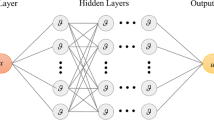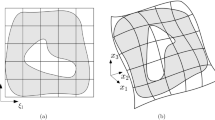Abstract
Numerical simulations of the anisotropic mechanical properties of soft tissues and tissue-derived biomaterials using accurate constitutive models remain an important and challenging research area in biomechanics. While most constitutive modeling efforts have focused on the characterization of experimental data, only limited studies are available on the feasibility of utilizing those models in complex computational applications. An example is the widely utilized exponential constitutive model proposed by Fung. Although present in the biomechanics literature for several decades, implementation of this model into finite element (FE) simulations has been limited. A major reason for limited numerical implementations are problems associated with inherent numerical instability and convergence. To address this issue, we developed and applied two restrictions for a generalized Fung-elastic constitutive model necessary to achieve numerical stability. These are (1) convexity of the strain energy function, and (2) the condition number of material stiffness matrix set lower than a prescribed value. These constraints were implemented in the nonlinear regression used for constitutive model parameter estimation to the experimental biaxial mechanical data. We then implemented the generalized Fung-elastic model into a commercial FE code (ABAQUS, Pawtucket, RI, USA). Single element and multi-element planar biaxial test simulations were conducted to verify the accuracy and robustness of the implementation. Results indicated that numerical convergence and accurate FE implementation were consistently obtained. The present study thus presents an integrated framework for accurate and robust implementation of pseudo-elastic constitutive models for planar soft tissues. Moreover, since our approach is formulated within a general FE code, it can be straightforwardly adopted across multiple software platforms.






Similar content being viewed by others
References
Billiar KL, Sacks MS (2000) Biaxial mechanical properties of the native and glutaraldehyde-treated aortic valve cusp: Part II-A structural constitutive model. J Biomech Eng 122(4):327–335
Chew PH, Yin FC, Zeger SL (1986) Biaxial stress–strain properties of canine pericardium. J Mol Cell Cardiol 18(6):567–578
Criscione JC, Humphrey JD, Douglas AD, Hunter WC (2000) An invariant basis for natural strain which yields orthogonal stress response terms in isotropic hyperelasticity. J Mech Phys Solids 48:2445–2465
Criscione JC, Sacks MS, Hunter WC (2003a) Experimentally tractable, pseudo-elastic constitutive law for biomembranes: I. Theory. J Biomech Eng 125(1):94–99
Criscione JC, Sacks MS, Hunter WC (2003b) Experimentally tractable, pseudo-elastic constitutive law for biomembranes: II. Application. J Biomech Eng 125(1):100–105
Fung YC (1993) Biomechanics: mechanical properties of living tissues. Springer, New York
Fung Y, Tong P (eds) (2001) Classical and computational solid mechanics. Advanced series in engineering science. World Scientific Publishing
Gardiner JC, Weiss JA (2001) Simple shear testing of parallel-fibered planar soft tissues. J Biomech Eng 123(2):170–175
Hildebrand F (1980) Advanced calculus for applications
Holzapfel GA (2000) Nonlinear solid mechanics: a continuum approach for engineering. Wiley, Chichester New York
Holzapfel GA, Gasser TC (2000) A new constitutive framework for arterial wall mechanics and a comparative study of material models. J Elasticity 61:1–48
Holzapfel GA, Eberlein R, Wriggers P, Weizascker HW (1996) Large strain analysis of soft biological membranes: formulatin and finite element analysis. Comput Methods Appl Mech Eng 132:45–61
Humphrey JD (2002) Cardiovascular solid mechanics: cells, tissues, and organs. Springer, New York
Humphrey JD, Na S (2002) Elastodynamics and arterial wall stress. Ann Biomed Eng 30(4):509–523
Humphrey JD, Vawter DL, Vito RP (1987) Pseudoelasticity of excised visceral pleura. J Biomech Eng 109:115–120
Humphrey JD, Strumpf RK, Yin FC (1990a) Determination of a constitutive relation for passive myocardium: I. A new functional form. J Biomech Eng 112(3):333–339
Humphrey JD, Strumpf RK, Yin FC (1990b) Determination of a constitutive relation for passive myocardium: II. Parameter estimation. J Biomech Eng 112(3):340–346
Humphrey JD, Strumpf RK, Yin FCP (1992) A constitutive theory for biomembranes: application to epicardial mechanics. J Biomech Eng 114:461–466
Kyriacou SK, Shah AD, Humphrey JD (1997) Inverse finite element characterization of nonlinear hyperelastic membranes. J Appl Mech 64(June):257–262
Lanir Y (1994) Plausibility of structural constitutive equations for isotropic soft tissues in finite static deformations. J Appl Mech 61:695–702
Lanir Y (1996) Plausibility of structural constitutive equations for swelling tissues—implications of the C–N and S–E conditions. J Biomech Eng 118:10–16
Lanir Y, Lichtenstein O, Imanuel O (1996) Optimal design of biaxial tests for structural material characterization of flat tissues. J Biomech Eng 118:41–47
Marsden JE, Hughes TJR (1983) Mathematical foundations of elasticity. Dover, Don Mills
Nielsen PMF, Hunter PJ, Smaill BH (1991) Biaxial testing of membrane biomaterials: testing equipment and procedures. J Biomech Eng 113:295–300
Ogden RW (1997) Non-linear elastic deformations. Dover, Toronto
Ogden R (2003) Nonlinear elasticity, anisotropy, material stability, and residual stresses in soft tissue. In: Ogden R (ed) Biomechanics of soft tissue in cardiovascular system. Springer, New York
Sacks MS (1999) A method for planar biaxial mechanical testing that includes in-plane shear. J Biomech Eng 121(5):551–555
Sacks MS (2000) Biaxial mechanical evaluation of planar biological materials. J Elasticity 61:199–246
Sacks MS (2003) Incorporation of experimentally-derived fiber orientation into a structural constitutive model for planar collagenous tissues. J Biomech Eng 125(2):280–287
Sacks MS, Chuong CJ (1998) Orthotropic mechanical properties of chemically treated bovine pericardium. Ann Biomed Eng 26(5):892–902
Sacks MS, Sun W (2003) Multiaxial mechanical behavior of biological materials. Annu Rev Biomed Eng
Schroder J, Neff P (2003) Aspects of formulation of hyperelastic soft tissues with polyconvex anisotropic strain energies. Second MIT conference on computational fluid and solid mechanics. MIT, Cambridge MA
Sun W, Sacks MS, Sellaro TL, Slaughter WS, Scott MJ (2003) Biaxial mechanical response of bioprosthetic heart valve biomaterials to high in-plane shear. J Biomech Eng 125:372–380
Sun W, Scott MJ, Sacks MS (2005) Effects of boundary conditions on the planar biaxial mechanical properties of soft tissues. ASME J Biomech Eng (in press)
Tong P, Fung YC (1976) The stress–strain relationship for the skin. J Biomech 9(10):649–657
Truesdell C, Noll W (1965) The Nonlinear Field Theories. Handbuch der Physik. S Flugge. Springer, Berlin, pp 119–126
Weiss JA, Maker BN, Govindjee S (1996) Finite element implementation of incompressible, transversely isotropic hyperelasticity. Comput Methods Biomech Biomed Eng 135:107–128
Wilber JP, Walton JR (2002) The convexity properties of a class of constitutive models for biological soft tissues. Math Mech Solids 7:217–236
Acknowledgements
Funding for this work was provided by NSF Grant BES-9978858, NIH Grant R01-HL071814-01A1 and by Edwards Lifesciences, Inc. MSS is an Established Investigator of the American Heart Association. The authors would also like to thank Dr. Michael J. Scott for his practical insights into the present work.
Author information
Authors and Affiliations
Corresponding author
Rights and permissions
About this article
Cite this article
Sun, W., Sacks, M.S. Finite element implementation of a generalized Fung-elastic constitutive model for planar soft tissues. Biomech Model Mechanobiol 4, 190–199 (2005). https://doi.org/10.1007/s10237-005-0075-x
Received:
Accepted:
Published:
Issue Date:
DOI: https://doi.org/10.1007/s10237-005-0075-x




